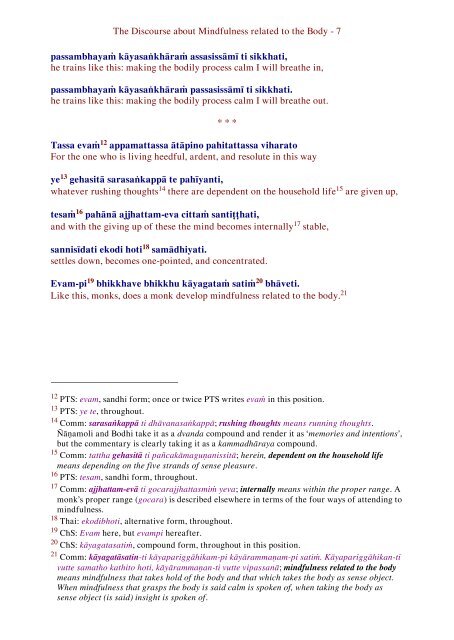Kayagatasatisuttam, the Discourse about Mindfulness related to the Body
A Pāli and English line by line (interlinear) version of this important discourse about the development of various meditations related to the body (together with extensive annotation).
A Pāli and English line by line (interlinear) version of this important discourse about the development of various meditations related to the body (together with extensive annotation).
You also want an ePaper? Increase the reach of your titles
YUMPU automatically turns print PDFs into web optimized ePapers that Google loves.
The <strong>Discourse</strong> <strong>about</strong> <strong>Mindfulness</strong> <strong>related</strong> <strong>to</strong> <strong>the</strong> <strong>Body</strong> - 7<br />
passambhayaṁ kāyasaṅkhāraṁ assasissāmī ti sikkhati,<br />
he trains like this: making <strong>the</strong> bodily process calm I will brea<strong>the</strong> in,<br />
passambhayaṁ kāyasaṅkhāraṁ passasissāmī ti sikkhati.<br />
he trains like this: making <strong>the</strong> bodily process calm I will brea<strong>the</strong> out.<br />
* * *<br />
Tassa evaṁ 12 appamattassa ātāpino pahitattassa vihara<strong>to</strong><br />
For <strong>the</strong> one who is living heedful, ardent, and resolute in this way<br />
ye 13 gehasitā sarasaṅkappā te pahīyanti,<br />
whatever rushing thoughts 14 <strong>the</strong>re are dependent on <strong>the</strong> household life 15 are given up,<br />
tesaṁ 16 pahānā ajjhattam-eva cittaṁ santiṭṭhati,<br />
and with <strong>the</strong> giving up of <strong>the</strong>se <strong>the</strong> mind becomes internally 17 stable,<br />
sannisīdati ekodi hoti 18 samādhiyati.<br />
settles down, becomes one-pointed, and concentrated.<br />
Evam-pi 19 bhikkhave bhikkhu kāyagataṁ satiṁ 20 bhāveti.<br />
Like this, monks, does a monk develop mindfulness <strong>related</strong> <strong>to</strong> <strong>the</strong> body. 21<br />
12 PTS: evam, sandhi form; once or twice PTS writes evaṁ in this position.<br />
13 PTS: ye te, throughout.<br />
14 Comm: sarasaṅkappā ti dhāvanasaṅkappā; rushing thoughts means running thoughts.<br />
Ñāṇamoli and Bodhi take it as a dvanda compound and render it as ‘memories and intentions’,<br />
but <strong>the</strong> commentary is clearly taking it as a kammadhāraya compound.<br />
15 Comm: tattha gehasitā ti pañcakāmaguṇanissitā; herein, dependent on <strong>the</strong> household life<br />
means depending on <strong>the</strong> five strands of sense pleasure.<br />
16 PTS: tesam, sandhi form, throughout.<br />
17 Comm: ajjhattam-evā ti gocarajjhattasmiṁ yeva; internally means within <strong>the</strong> proper range. A<br />
monk’s proper range (gocara) is described elsewhere in terms of <strong>the</strong> four ways of attending <strong>to</strong><br />
mindfulness.<br />
18 Thai: ekodibhoti, alternative form, throughout.<br />
19 ChS: Evam here, but evampi hereafter.<br />
20 ChS: kāyagatasatiṁ, compound form, throughout in this position.<br />
21 Comm: kāyagatāsatin-ti kāyapariggāhikam-pi kāyārammaṇam-pi satiṁ. Kāyapariggāhikan-ti<br />
vutte samatho kathi<strong>to</strong> hoti, kāyārammaṇan-ti vutte vipassanā; mindfulness <strong>related</strong> <strong>to</strong> <strong>the</strong> body<br />
means mindfulness that takes hold of <strong>the</strong> body and that which takes <strong>the</strong> body as sense object.<br />
When mindfulness that grasps <strong>the</strong> body is said calm is spoken of, when taking <strong>the</strong> body as<br />
sense object (is said) insight is spoken of.

















